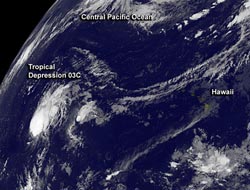NASA Sees Another New Central Pacific Tropical Cyclone

NOAA's GOES-West satellite imagery from Aug. 20 at 1200 UTC/8 a.m. EDT showed a rounded tropical depression about 1,310 miles/2,105 km west of Lihue, Hawaii. Image Credit: NASA GOES Project<br>
NOAA's GOES-West satellite imagery from Aug. 20 at 1200 UTC/8 a.m. EDT showed a rounded tropical depression about 1,310 miles/2,105 km west of Lihue, Hawaii.
The GOES image was created by the NASA GOES Project at NASA's Goddard Space Flight Center in Greenbelt, Md. The GOES image shows the strongest thunderstorms around the depression's center.
The depression was centered near 19.5 north latitude and 179.5 west longitude. Maximum sustained winds are near 35 mph/55 kph. Tropical Depression 03C (TD03C) is moving to the west-northwest at 16 mpg/26 kph and the Central Pacific Hurricane Center expects it to continue moving in that direction for the next couple of days. There are no warnings or watches associated with the depression.
Like the previous two tropical cyclones born in the Central Pacific, this one is moving west and is expected to cross the International Dateline. That means that NOAA's Central Pacific Hurricane Center will not be issuing updates on the system as it will fall under the forecast authority of the Joint Typhoon Warning Center.
TD03C is expected to continue tracking west-northwest, it is being steered by a mid-to-upper level ridge (elongated area) of high pressure to the north of the system. No change in strength is expected in the next day.
Text credit: Rob Gutro
NASA's Goddard Space Flight Center
Media Contact
All latest news from the category: Earth Sciences
Earth Sciences (also referred to as Geosciences), which deals with basic issues surrounding our planet, plays a vital role in the area of energy and raw materials supply.
Earth Sciences comprises subjects such as geology, geography, geological informatics, paleontology, mineralogy, petrography, crystallography, geophysics, geodesy, glaciology, cartography, photogrammetry, meteorology and seismology, early-warning systems, earthquake research and polar research.
Newest articles

A universal framework for spatial biology
SpatialData is a freely accessible tool to unify and integrate data from different omics technologies accounting for spatial information, which can provide holistic insights into health and disease. Biological processes…

How complex biological processes arise
A $20 million grant from the U.S. National Science Foundation (NSF) will support the establishment and operation of the National Synthesis Center for Emergence in the Molecular and Cellular Sciences (NCEMS) at…

Airborne single-photon lidar system achieves high-resolution 3D imaging
Compact, low-power system opens doors for photon-efficient drone and satellite-based environmental monitoring and mapping. Researchers have developed a compact and lightweight single-photon airborne lidar system that can acquire high-resolution 3D…





















